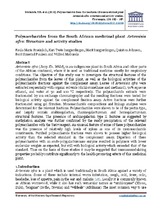| dc.contributor.author | Braunlich, Paula Marie | |
| dc.contributor.author | Inngjerdingen, Kari Tvete | |
| dc.contributor.author | Inngjerdingen, Marit | |
| dc.contributor.author | Johnson, Quinton | |
| dc.contributor.author | Paulsen, Berit Smestad | |
| dc.contributor.author | Mabusela, Wilfred | |
| dc.date.accessioned | 2018-01-05T06:51:45Z | |
| dc.date.available | 2018-01-05T06:51:45Z | |
| dc.date.issued | 2018 | |
| dc.identifier.citation | Braünlich, P.M. et al. (2018). Polysaccharides from the Southern African medicinal plant Artemisia afra: structure and activity studies. Fitoterapia, 124: 182 – 187 | en_US |
| dc.identifier.issn | 0367-326X | |
| dc.identifier.uri | http://dx.doi.org/10.1016/j.fitote.2017.11.016 | |
| dc.identifier.uri | http://hdl.handle.net/10566/3351 | |
| dc.description.abstract | Artemisia afra (Jacq. Ex. Willd), is an indigenous plant in South Africa and other parts of the African continent, where it is used as traditional medicine mostly for respiratory conditions. The objective of this study was to investigate the structural features of the polysaccharides from the leaves of this plant, as well as the biological activities of the polysaccharide fractions against the complement assay. Leaves of Artemisia afra were extracted sequentially with organic solvents (dichloromethane and methanol), 50% aqueous ethanol, and water at 50 and 100 °C respectively. The polysaccharide extracts were fractionated by ion exchange chromatography and the resulting fractions were tested for biological activity against the complement fixation assay. Active fractions were further fractionated using gel filtration. Monosaccharide compositions and linkage analyses were determined for the relevant fractions. Polysaccharides were shown to be of the pectin type, and largely contain arabinogalactan, rhamnogalacturonan and homogalacturonan structural features. The presence of arabinogalactan type II features as suggested by methylation analysis was further confirmed by the ready precipitation of the relevant polysaccharides with the Yariv reagent. An unusual feature of some of these polysaccharides was the presence of relatively high levels of xylose as one of its monosaccharide constituents. Purified polysaccharide fractions were shown to possess higher biological activity than the selected standard in the complement assay. Digestion of these polysaccharides with an endo-polygalacturonase enzyme resulted in polymers with lower molecular weights as expected, but still with biological activity which exceeded that of the standard. Thus on the basis of these studies it may be suggested that immunomodulating properties probably contribute significantly to the health-promoting effects of this medicinal plant. | en_US |
| dc.language.iso | en | en_US |
| dc.publisher | Elsevier | en_US |
| dc.rights | This is the author-version of the article published online at: http://dx.doi.org/10.1016/j.fitote.2017.11.016 | |
| dc.subject | Polysaccharides | en_US |
| dc.subject | South Africa | en_US |
| dc.subject | Indigenous plant | en_US |
| dc.subject | Traditional medicine | en_US |
| dc.subject | Composition | en_US |
| dc.title | Polysaccharides from the South African medicinal plant Artemisia afra: Structure and activity studies | en_US |
| dc.type | Article | en_US |
| dc.privacy.showsubmitter | FALSE | |
| dc.status.ispeerreviewed | TRUE | |

